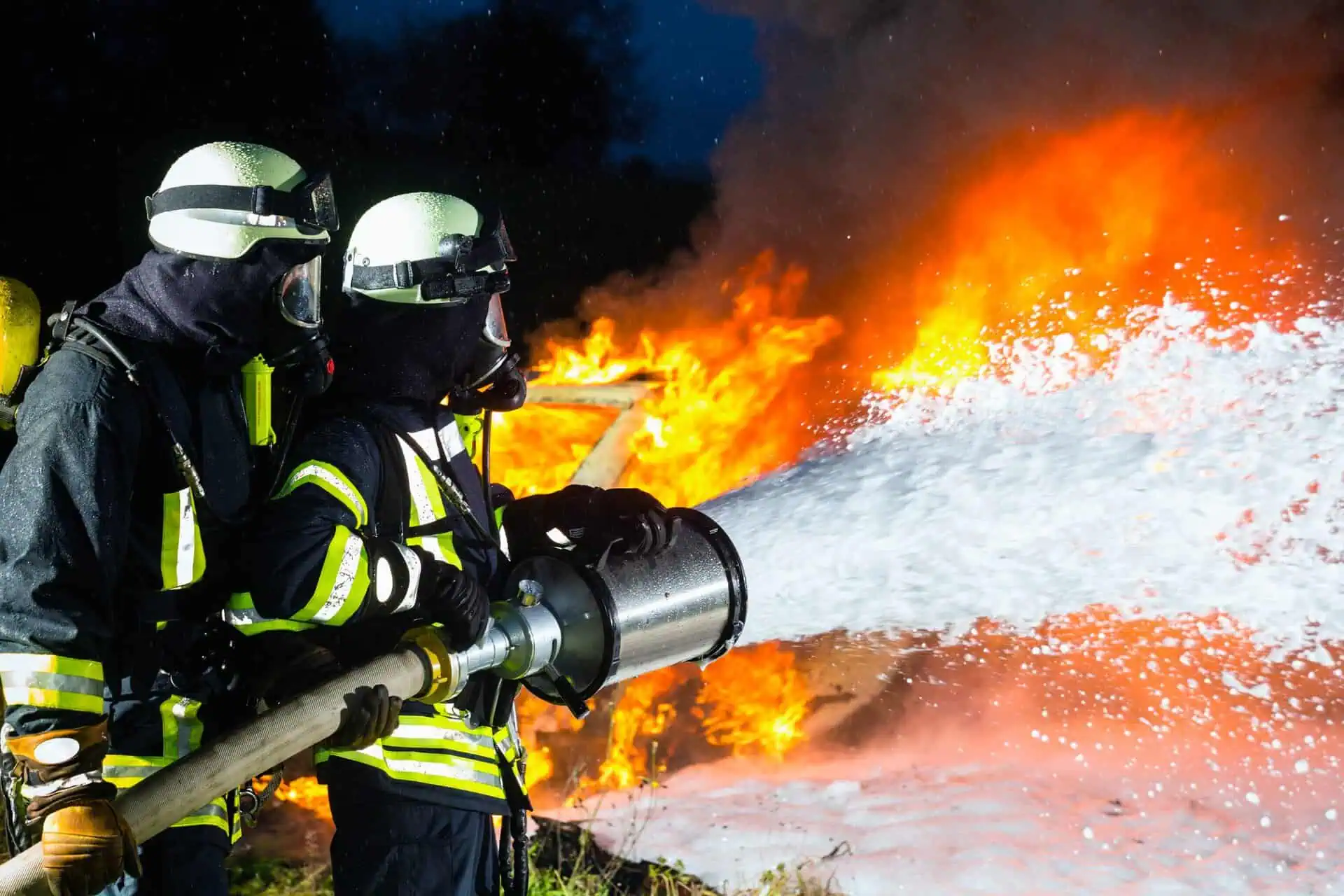AFFF Pancreatic Cancer Lawsuit
- Last Updated: July 7th, 2025

Attorney Jessica Paluch-Hoerman, founder of TruLaw, has over 28 years of experience as a personal injury and mass tort attorney, and previously worked as an international tax attorney at Deloitte. Jessie collaborates with attorneys nationwide — enabling her to share reliable, up-to-date legal information with our readers.
Legally Reviewed
This article has been written and reviewed for legal accuracy and clarity by the team of writers and legal experts at TruLaw and is as accurate as possible. This content should not be taken as legal advice from an attorney. If you would like to learn more about our owner and experienced injury lawyer, Jessie Paluch, you can do so here.
Fact-Checked
TruLaw does everything possible to make sure the information in this article is up to date and accurate. If you need specific legal advice about your case, contact us by using the chat on the bottom of this page. This article should not be taken as advice from an attorney.
Key takeaways:
- You can still file an AFFF pancreatic cancer lawsuit in 2025, with the statute of limitations running from diagnosis or death date rather than exposure date.
- Military personnel, firefighters, and airport workers exposed at any of 455 confirmed PFAS-contaminated military installations qualify, with June 20, 2025 Science Days potentially adding pancreatic cancer to recognized conditions.
- TruLaw works on contingency fees (no payment unless you win) and accepts cases with DD-214 military records, employment history, or witness statements as exposure proof.
Can I Still File an AFFF Pancreatic Cancer Lawsuit?
Question: Can I still file an AFFF pancreatic cancer lawsuit?
Answer: Yes, you can still file an AFFF pancreatic cancer lawsuit in 2025 as personal injury cases continue being accepted into the AFFF firefighting foam MDL (MDL 2873), with new pancreatic cancer claims joining the litigation weekly as more families connect their loved ones’ deaths to firefighting foam exposure.
The statute of limitations for pancreatic cancer cases typically runs from the date of diagnosis or death rather than exposure date, providing opportunities for recently diagnosed patients and families who lost loved ones to this aggressive cancer.
On this page, we’ll discuss this question in further depth, major defendants in AFFF litigation, timing considerations for pancreatic cancer claims, and much more.
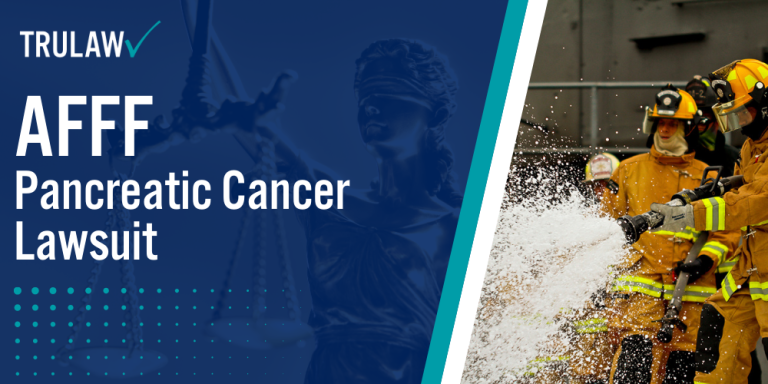
How PFAS Chemicals Target Pancreatic Tissue
PFAS chemicals from AFFF foam concentrate in pancreatic tissue due to the organ’s role in filtering blood and producing digestive enzymes, creating a toxic environment that promotes cancerous cell mutations.
The bioaccumulation of these forever chemicals disrupts normal pancreatic function, interfering with insulin production and enzyme secretion while damaging DNA repair mechanisms.
Research indicates PFAS exposure can activate oncogenes and suppress tumor suppressor genes specifically within pancreatic cells, accelerating cancer development.
If you or someone you love has been diagnosed with pancreatic cancer after AFFF exposure, you may be eligible to seek compensation.
Contact TruLaw using the chat on this page to receive an instant case evaluation that can help you determine if you qualify to file an AFFF Lawsuit today.
Table of Contents
AFFF and Its Connection to Pancreatic Cancer
The relationship between AFFF firefighting foam and pancreatic cancer centers on the dangerous PFAS chemicals contained within these fire suppressants.
Learning about both the composition of AFFF and the growing body of scientific research linking these toxic chemicals to pancreatic cancer provides the foundation for current litigation efforts.
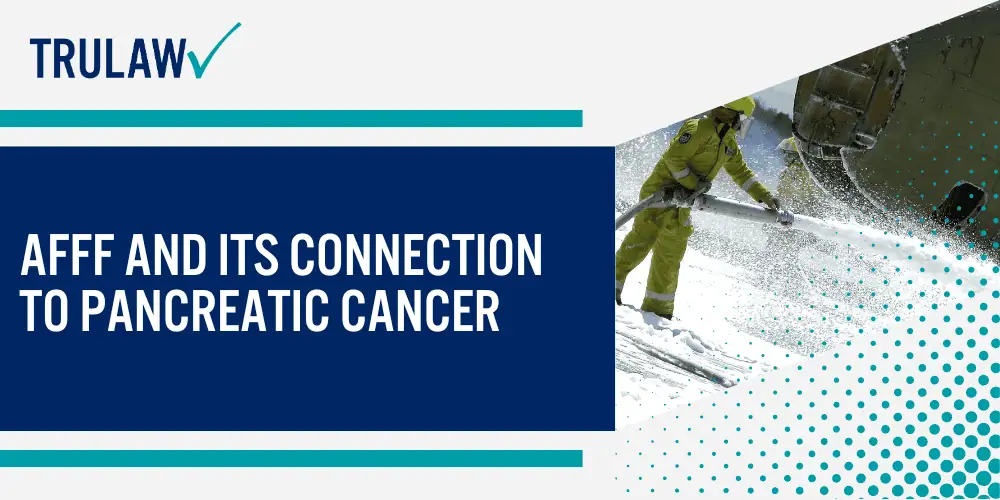
As courts examine the evidence connecting AFFF exposure to various cancers, pancreatic cancer represents an emerging area of legal recognition with substantial implications for those who have developed this aggressive disease following firefighting foam exposure.
Learning About AFFF Firefighting Foam and PFAS Chemicals
Aqueous Film-Forming Foam (AFFF) represents a highly effective firefighting suppressant developed in the early 1960s through collaboration between the U.S. Navy and 3M Corporation.
Originally designed to combat high-heat petroleum-based fires, AFFF became the standard fire suppression method for military installations, airports, and civilian fire departments worldwide.
The composition and widespread adoption of AFFF typically include:
- PFAS Chemical Content: AFFF concentrates contain up to 15-18% surfactants, with synthetic chemicals making up the active ingredients that create the film-forming properties.
- Historical Usage Timeline: 3M served as the sole supplier from the mid-1960s until 1973, with the U.S. Navy requiring AFFF on all vessels by the late 1960s.
- Military Implementation: The Department of Defense (including the US Air Force) began widespread AFFF deployment at all military installations throughout the 1970s.
- Commercial Availability: AFFF is sold as concentrates in 1%, 3%, and 6% ratios for mixing with water during firefighting operations.
- PFAS Persistence: These “forever chemicals” do not readily decompose in the environment and remain biologically persistent in the human body.
The effectiveness of AFFF in suppressing fuel fires made it an indispensable tool across military and civilian applications.
However, the same PFAS chemicals that provide AFFF’s fire-suppressing capabilities also pose serious health risks to those exposed during training exercises, actual firefighting operations, and through environmental contamination.
If you or a loved one developed pancreatic cancer after exposure to AFFF firefighting foam, you may be eligible to seek compensation.
Contact TruLaw using the chat on this page to receive an instant case evaluation and determine whether you qualify to file an AFFF lawsuit today.
Scientific Studies Linking PFAS Exposure to Pancreatic Cancer
Recent scientific research has established concerning connections between PFAS exposure from AFFF and pancreatic cancer development.
The 2022 study published in Gastrointestinal Cancer Research demonstrated that perfluorooctanoic acid (PFOA), a primary component of AFFF, leads directly to pancreatic cancer promotion in laboratory studies.
Research findings linking PFAS to pancreatic cancer commonly feature:
- Oxidative Stress Induction: PFOA exposure triggers substantial oxidative stress in pancreatic tissues, creating cellular damage that can lead to cancer development
- Dose-Response Analysis: Researchers observed pancreatic tumor development even at extremely low PFOA concentrations, suggesting current Environmental Protection Agency health advisory levels may be inadequate
- Inflammatory Response: PFAS chemicals induce pro-inflammatory cytokines and increase reactive oxygen species production in human cells
- Cellular Mechanism: Studies show PFAS disrupts normal cellular processes and damages proteins, lipids, and DNA within pancreatic tissues
- Environmental Persistence: Unlike other toxins, PFAS accumulate in the body over time, creating prolonged exposure effects that increase cancer risk
The Indiana University School of Medicine research revealed that individuals with prolonged exposure to PFAS-contaminated drinking water showed higher incidences of chronic pancreatitis, a well-documented precursor to pancreatic cancer.
Additional studies from the National Cancer Institute have identified associations between several PFAS chemicals and various cancer types, with pancreatic cancer emerging as a major concern alongside prostate cancer and other malignancies.
Dose-response analysis conducted by researchers suggests that the lifetime human exposure limit for PFOA should be approximately 700 times lower than current EPA health advisory levels.
This finding indicates that even minimal AFFF exposure may pose substantial pancreatic cancer risks, particularly for individuals with occupational or environmental exposure over extended periods.
Why Pancreatic Cancer Cases Are Being Added to AFFF Litigation
The AFFF multidistrict litigation currently recognizes six specific conditions associated with PFAS exposure: kidney cancer, testicular cancer, ulcerative colitis, thyroid disease, thyroid cancer, and liver cancer.
However, AFFF firefighting foam cases involving pancreatic cancer are gaining substantial momentum within the legal proceedings as scientific evidence continues to strengthen.
Current developments in pancreatic cancer recognition often involve:
- Science Days Scheduling: The court has scheduled two Science Days for June 2025, with the second session on June 20th specifically focusing on research linking PFAS exposure to various cancers
- Judicial Review Process: Judge Richard M. Gergel is evaluating additional scientific evidence to determine whether pancreatic cancer should join the recognized conditions list
- Growing Case Volume: Legal experts anticipate AFFF cancer lawsuits will include pancreatic cancer cases in settlement negotiations as the scientific discussion evolves within the MDL framework
- Advocacy Efforts: Firefighting foam attorneys representing AFFF victims are actively presenting pancreatic cancer research to support inclusion in future bellwether trials
- Timeline Expectations: Legal analysts project pancreatic cancer recognition may occur within 12-18 months based on ongoing scientific presentations
The AFFF MDL, consolidated in the U.S. District Court for the District of South Carolina, currently includes over 6,000 pending cases.
As the scientific evidence supporting pancreatic cancer causation continues to mount, these cases represent an emerging area of substantial legal opportunity for affected individuals.
Manufacturers including 3M, Tyco Fire Products, and other defendants have made multiple attempts to dismiss AFFF claims, but the AFFF firefighting foam litigation remains active and is proceeding.
The upcoming Science Days will provide opportunities for comprehensive scientific presentations that may influence the court’s decisions regarding pancreatic cancer inclusion in settlement discussions.
If you or a loved one suffered pancreatic cancer following AFFF firefighting foam exposure, you may be eligible to file an AFFF firefighting foam lawsuit.
Contact TruLaw using the chat on this page to receive an instant case evaluation and determine whether you qualify to join others in filing an AFFF lawsuit today.
Who Qualifies for an AFFF Pancreatic Cancer Lawsuit?
Determining eligibility for an AFFF pancreatic cancer lawsuit requires meeting specific exposure and medical criteria that establish both causation and legal standing.
Qualifying for these claims involves demonstrating occupational or environmental AFFF exposure combined with a confirmed pancreatic cancer diagnosis, along with sufficient documentation to support the connection between exposure and illness.
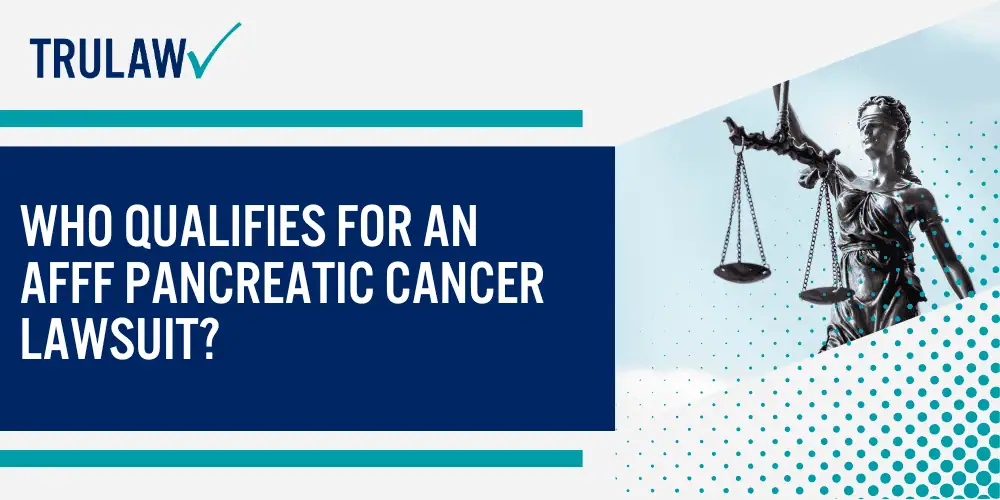
Learning about the precise requirements for AFFF pancreatic cancer litigation helps potential plaintiffs assess their cases and take appropriate legal action within applicable deadlines.
Exposure Requirements and At-Risk Populations
AFFF pancreatic cancer lawsuit eligibility centers on proving substantial exposure to firefighting foams containing harmful chemicals through occupational or environmental pathways.
Successful claims typically require demonstrating regular or major exposure over extended periods, rather than isolated incidents.
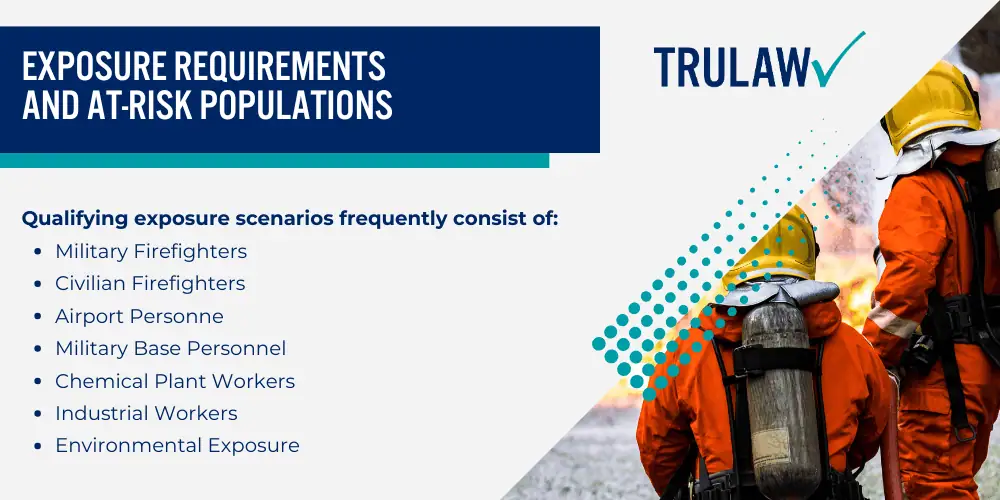
Qualifying exposure scenarios frequently consist of:
- Military Firefighters: Active duty and veteran personnel who used AFFF during training exercises, actual firefighting operations, or routine maintenance at military installations
- Civilian Firefighters: Municipal, county, and private firefighters who regularly handled AFFF during suppression activities, training sessions, or equipment maintenance
- Airport Personnel: Workers at commercial and military airports who were exposed to AFFF during aircraft emergency response training or actual incident responses
- Military Base Personnel: Service members and civilian employees stationed at installations where AFFF was used for fire suppression or training purposes
- Chemical Plant Workers: Employees at facilities manufacturing PFAS chemicals or AFFF products who encountered these substances during production processes
- Industrial Workers: Employees at refineries, chemical plants, and manufacturing facilities where AFFF systems were installed for fire protection
- Environmental Exposure: Individuals living near military bases, airports, or manufacturing facilities with documented PFAS groundwater contamination
The Department of Defense has confirmed PFAS contamination at 455 military installations across the United States, with investigations ongoing at more than 700 additional sites.
These locations provide strong evidence of exposure for individuals who worked or lived in affected areas during periods of AFFF use.
If you or a loved one worked as a firefighter, served at a military installation, or lived near a facility where AFFF was used and later developed pancreatic cancer, you may be eligible to seek compensation.
Contact TruLaw using the chat on this page to receive an instant case evaluation and determine whether you qualify to join others in filing an AFFF lawsuit today.
Evidence Needed to Support Your AFFF Pancreatic Cancer Case
Building a successful AFFF pancreatic cancer lawsuit requires comprehensive documentation that establishes both exposure history and medical causation through credible evidence.
The strength of your case depends on your ability to demonstrate clear connections between AFFF exposure and subsequent pancreatic cancer development, supported by thorough medical records and expert testimony.
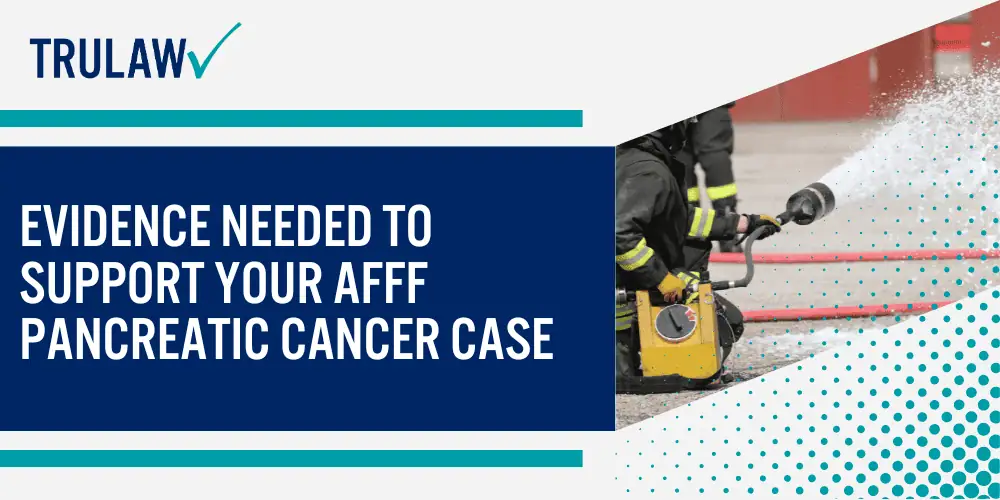
Proper evidence collection and preservation often determines the difference between successful compensation and case dismissal, making systematic documentation efforts important from the moment you suspect a connection between your exposure and illness.
Documenting AFFF Exposure History
Establishing credible AFFF exposure requires detailed documentation that proves when, where, and how you encountered firefighting foam containing PFAS chemicals.
This documentation must be comprehensive enough to satisfy legal causation standards and withstand scrutiny from defense attorneys representing manufacturers.
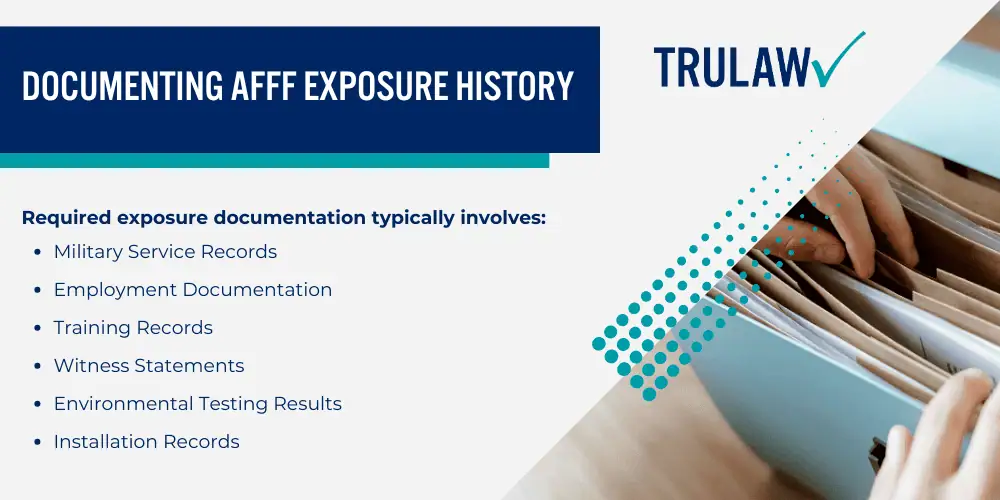
Required exposure documentation typically involves:
- Military Service Records: DD-214 discharge papers, service member records books, and unit assignment documentation showing service at installations where AFFF was used for firefighting or training
- Employment Documentation: Fire department personnel files, airport worker employment records, and chemical plant employment history establishing occupational exposure to AFFF products
- Training Records: Firefighting training logs, AFFF handling certifications, and emergency response training documentation showing direct foam exposure during exercises
- Witness Statements: Signed testimonies from colleagues, supervisors, and fellow service members who observed your AFFF exposure or can attest to routine foam usage at your workplace
- Environmental Testing Results: Government or independent testing reports showing PFAS contamination at military bases, airports, or fire stations where you worked
- Installation Records: Documentation proving AFFF usage at specific military installations, airports, or fire departments during your employment or service periods
The Department of Defense has confirmed PFAS contamination at 455 military installations, with investigations ongoing at more than 700 additional sites.
Veterans who served at these locations during periods of AFFF usage have strong documentary evidence supporting their exposure claims.
The VA provides guidance on evidence needed for disability claims related to toxic exposure.
Military personnel should prioritize obtaining complete DD-214 records and any available unit histories that document firefighting activities.
Civilian firefighters must gather employment records, training logs, and witness statements establishing regular or substantial AFFF exposure during their careers.
If you or a loved one have documentation showing AFFF exposure and later developed pancreatic cancer, you may be eligible to seek compensation.
Contact TruLaw using the chat on this page to receive an instant case evaluation and determine whether you qualify to join others in filing an AFFF lawsuit today.
How Can an AFFF Firefighting Foam Attorney from TruLaw Help You?
Our AFFF firefighting foam attorney at TruLaw is dedicated to supporting clients through the legal process of filing an AFFF firefighting foam lawsuit.
With extensive experience in chemical-exposure litigation, Jessica Paluch-Hoerman and our partner law firms work with industry leaders to prove how toxic PFAS chemicals in AFFF firefighting foam—and the resulting contamination of water supplies—caused you harm.
TruLaw focuses on securing financial compensation for medical expenses, pain and suffering, property damage, lost income, ongoing health monitoring, and other serious health issues resulting from your AFFF exposure.
We know the health and environmental impacts of AFFF firefighting foam on your life and provide the personalized guidance you need when seeking justice.
Meet the Lead AFFF Firefighting Foam Attorney at TruLaw
- Jessica Paluch-Hoerman: As founder and managing attorney of TruLaw, Jessica brings her product-liability and personal-injury experience to a client-centered approach that prioritizes open communication and personalized attention.Through TruLaw and its partner firms, she has helped recover more than $3 billion for injured individuals across all 50 states via verdicts and negotiated settlements.
How much does hiring an AFFF firefighting foam lawyer from TruLaw cost?
At TruLaw, we believe financial concerns should never stand in the way of justice.
We operate on a contingency-fee basis—you pay legal fees only after you recover compensation.
If you or a loved one developed cancer or another serious illness after long-term exposure to AFFF firefighting foam (or PFAS-contaminated water linked to AFFF use), you may be eligible to seek compensation.
Contact TruLaw using the chat on this page to receive an instant case evaluation and determine whether you qualify to join others in filing an AFFF Firefighting Foam Lawsuit today.
TruLaw: Accepting Clients for the AFFF Lawsuit
AFFF firefighting foam lawsuits are being filed by firefighters, military veterans, airport personnel, and others nationwide after years of repeated exposure to toxic firefighting foam (AFFF) that contains per- and polyfluoroalkyl substances (PFAS).
TruLaw is currently accepting clients for the AFFF firefighting foam lawsuit, working with experienced firefighting foam lawyers who know these health issues inside and out.
A few reasons to choose TruLaw for your AFFF firefighting foam lawsuit include:
- If We Don’t Win, You Don’t Pay: The AFFF firefighting foam lawyers at TruLaw and our partner firms work on a contingency-fee basis— we only get paid if you win.
- Expertise: We have decades of experience handling toxic-exposure cases like the AFFF firefighting foam lawsuit.
- Successful Track Record: TruLaw and our partner firms have helped clients recover billions of dollars in compensation through verdicts and negotiated settlements.
If you or a loved one developed cancer or another serious illness after long-term exposure to AFFF firefighting foam, you may be eligible to seek compensation.
Contact TruLaw using the chat on this page to receive an instant case evaluation and learn whether you qualify for the AFFF Lawsuit today.
AFFF Lawsuit Frequently Asked Questions
-
Pancreatic cancer is not yet officially included among the recognized conditions in the AFFF MDL, though it is gaining substantial momentum.
The court currently recognizes kidney cancer, testicular cancer, ulcerative colitis, thyroid disease, thyroid cancer, and liver cancer.
However, Science Days scheduled for June 2025 will present research on PFAS exposure and cancer connections, including pancreatic cancer.
Legal experts anticipate pancreatic cancer recognition may occur within 12-18 months based on evolving scientific evidence and ongoing advocacy efforts by AFFF lawyers representing affected victims.
-
The statute of limitations for AFFF pancreatic cancer lawsuits varies by state, typically ranging from 2-6 years from the date of injury or diagnosis.
However, most states apply discovery rules that start the limitation period when victims become aware their illness was linked to AFFF exposure.
Since AFFF manufacturers concealed related health risks for decades, many exposed individuals only recently learned about the connection, potentially extending filing deadlines.
Given the intricacies of these deadlines, consulting with experienced AFFF attorneys promptly after pancreatic cancer diagnosis is vital for protecting your legal rights.
-
You may still qualify for an AFFF pancreatic cancer lawsuit even without precise exposure documentation.
Circumstantial evidence can establish exposure, including employment at fire departments, military service at installations with documented AFFF usage, or residence near contaminated sites.
The Department of Defense has confirmed PFAS contamination at 455 military installations, providing strong evidence for veterans who served at these locations.
Witness statements from colleagues, training records, and occupational presumptions can support exposure claims.
Experienced AFFF attorneys can help gather circumstantial evidence and build compelling cases even with limited direct exposure documentation.
-
Yes, family members can file wrongful death claims on behalf of loved ones who died from pancreatic cancer following AFFF exposure.
These claims are typically filed by spouses, children, or estate representatives and may recover damages for medical expenses, lost income, funeral costs, loss of companionship, and even abdominal pain suffered before death.
Wrongful death claims often receive enhanced compensation beyond standard settlement tiers due to the profound impact on surviving family members.
However, wrongful death claims may have different statute of limitations periods than personal injury claims, making prompt legal consultation vital for protecting family members’ rights and preserving compensation opportunities.
-
Hiring an AFFF lawsuit attorney typically costs nothing upfront due to contingency fee arrangements.
Under these agreements, attorneys advance all case costs including expert witnesses, medical records, court fees, and discovery expenses, receiving payment only when settlements or verdicts are obtained.
Attorney fees are usually calculated as a percentage of the recovery, typically ranging from 33-40% depending on case intricacies and timing of resolution.
This structure ensures that affected individuals can access high-quality legal representation regardless of their financial circumstances, aligning attorney incentives with client success and eliminating financial barriers to pursuing justice.
-
Pancreatic cancer diagnosed years after AFFF exposure can still support successful AFFF lawsuits due to the extended latency periods common in toxic exposure cases.
Vital evidence includes complete medical records establishing cancer diagnosis and treatment history, employment or military service records showing AFFF exposure periods, and PFAS blood testing results if available.
Medical expert testimony linking exposure to cancer development proves vital for cases with extended latency periods.
The discovery rule in most states protects victims by starting limitation periods when causation becomes apparent rather than exposure dates, accommodating the delayed nature of PFAS-related human health effects.

Managing Attorney & Owner
With over 25 years of legal experience, Jessica Paluch-Hoerman is an Illinois lawyer, a CPA, and a mother of three. She spent the first decade of her career working as an international tax attorney at Deloitte.
In 2009, Jessie co-founded her own law firm with her husband – which has scaled to over 30 employees since its conception.
In 2016, Jessie founded TruLaw, which allows her to collaborate with attorneys and legal experts across the United States on a daily basis. This hypervaluable network of experts is what enables her to share the most reliable, accurate, and up-to-date legal information with our readers!
Additional AFFF Lawsuit resources on our website:
Here, at TruLaw, we’re committed to helping victims get the justice they deserve.
Alongside our partner law firms, we have successfully collected over $3 Billion in verdicts and settlements on behalf of injured individuals.
Would you like our help?
At TruLaw, we fiercely combat corporations that endanger individuals’ well-being. If you’ve suffered injuries and believe these well-funded entities should be held accountable, we’re here for you.
With TruLaw, you gain access to successful and seasoned lawyers who maximize your chances of success. Our lawyers invest in you—they do not receive a dime until your lawsuit reaches a successful resolution!
AFFF Lawsuit claims are being filed against manufacturers of aqueous film-forming foam (AFFF), commonly used in firefighting.
Claims allege that companies such as 3M, DuPont, and Tyco Fire Products failed to adequately warn users about the potential dangers of AFFF exposure — including increased risks of various cancers and diseases.
Depo Provera Lawsuit claims are being filed by individuals who allege they developed meningioma (a type of brain tumor) after receiving Depo-Provera birth control injections.
A 2024 study found that women using Depo-Provera for at least 1 year are five times more likely to develop meningioma brain tumors compared to those not using the drug.
Suboxone Tooth Decay Lawsuit claims are being filed against Indivior, the manufacturer of Suboxone, a medication used to treat opioid addiction.
Claims allege that Indivior failed to adequately warn users about the potential dangers of severe tooth decay and dental injuries associated with Suboxone’s sublingual film version.
Social Media Harm Lawsuits are being filed against social media companies for allegedly causing mental health issues in children and teens.
Claims allege that companies like Meta, Google, ByteDance, and Snap designed addictive platforms that led to anxiety, depression, and other mental health issues without adequately warning users or parents.
Transvaginal Mesh Lawsuits are being filed against manufacturers of transvaginal mesh products used to treat pelvic organ prolapse (POP) and stress urinary incontinence (SUI).
Claims allege that companies like Ethicon, C.R. Bard, and Boston Scientific failed to adequately warn about potential dangers — including erosion, pain, and infection.
Bair Hugger Warming Blanket Lawsuits involve claims against 3M — alleging their surgical warming blankets caused severe infections and complications (particularly in hip and knee replacement surgeries).
Plaintiffs claim 3M failed to warn about potential risks — despite knowing about increased risk of deep joint infections since 2011.
Baby Formula NEC Lawsuit claims are being filed against manufacturers of cow’s milk-based baby formula products.
Claims allege that companies like Abbott Laboratories (Similac) and Mead Johnson & Company (Enfamil) failed to warn about the increased risk of necrotizing enterocolitis (NEC) in premature infants.
Here, at TruLaw, we’re committed to helping victims get the justice they deserve.
Alongside our partner law firms, we have successfully collected over $3 Billion in verdicts and settlements on behalf of injured individuals.
Would you like our help?
